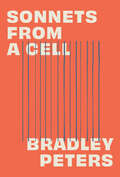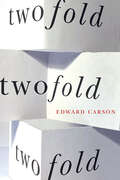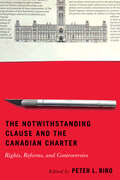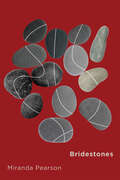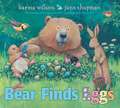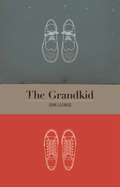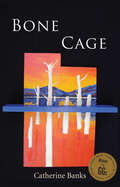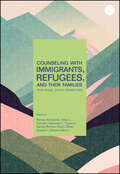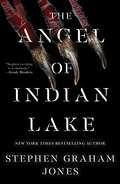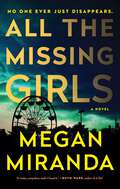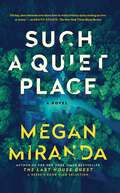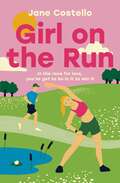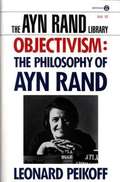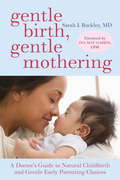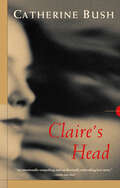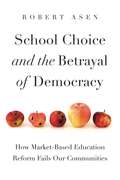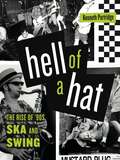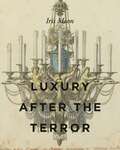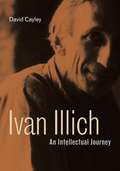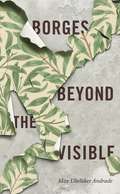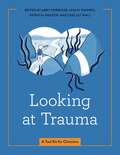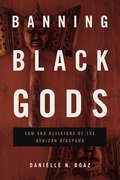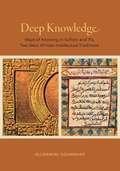- Table View
- List View
Sonnets from a Cell
by Bradley PetersWinner 2023 Alcuin AwardPoems for and about the incarcerated. Moving from riots to mall parkades to church, the poems in Bradley Peters' debut Sonnets from a Cell mix inmate speech, prison psychology, skateboard slang and contemporary lyricism in a way that is tough and tender, that is accountable both to Peters' own days "caught between the past and nothing" and to the structures that sentence so many "to lose." Written behind doors our culture too often keeps closed, this is poetry reaching out for moments of longing, wild joy and grace. Drawing on his own experiences as a teenager and young adult in and out of the Canadian prison system, Peters has written both a personal reckoning and a damning and eloquent account of our violence- and enforcement-obsessed capitalist and patriarchal cultures.
twofold (Hugh MacLennan Poetry Series)
by Edward CarsonThe poet Charles Simic wrote, “Short poems: be brief and tell us everything.”Edward Carson’s extraordinary new work gathers concise diptych – or twofold – poems exploring themes of love, relationships, myth, art, language, math, physics, geometry, and artificial intelligence. Within the two sections of twofold, “dialogues” and “binaries,” the form of the diptych shapes language and meaning as paired poems engage each other across the margins of facing pages. Caroline Bem, author of A Moveable Form, writes: “The diptych, you see, is beautiful. It is symmetry and difference, doubling and mirroring, binarism and seriality. It is the form of paradox, both open and closed, free and contained.”Negotiating surprising twinning combinations, comparisons, and outcomes, the poems in twofold are lively, thought-provoking, and playful interchanges that are also mischievously literate, questioning, and intuitive.
The Notwithstanding Clause and the Canadian Charter: Rights, Reforms, and Controversies
by Peter L. BiroSection 33 – what is commonly referred to as the notwithstanding clause (NWC) – was written into the Canadian Charter of Rights and Freedoms to allow Parliament and the provinces to provisionally override certain Charter rights.The Notwithstanding Clause and the Canadian Charter examines the NWC from all angles and perspectives, considering who should have the last word on matters of rights and justice – the legislatures or the unelected judiciary – and what balance liberal democracy requires. In the case of Quebec, the use of the clause has been justified as necessary to preserve the province’s culture and promote its identity as a nation. Yet Quebec’s pre-emptive and sweeping invocation of the clause also challenges the scope of judicial review and citizens’ recourse to it, and it tests the assumption that a dialogue between the judiciary and the legislature is always preferable in instances in which the legislative branch decides to suspend the operation of certain Charter rights and freedoms. By virtue of its contested purposes, interpretations, operation, and applications, the NWC represents and, to an extent, defines both the character and the very real vulnerabilities of liberal constitutionalism in Canada.The significance, effects, and legitimacy of the NWC have been vigorously debated within scholarship and among politicians and activists since the patriation of the Canadian Constitution in 1982. In The Notwithstanding Clause and the Canadian Charter leading scholars, jurists, and policy experts elucidate and prescribe reforms to the application of this consequential clause about which so much is written, and around which there is relatively little consensus.
Bridestones (Hugh MacLennan Poetry Series)
by Miranda PearsonCome, anguish. Help us manage / the plainsong of an open shore, / its language of high tide rich and close, / close and hard to see.The early elegiac poems in Bridestones emerge from the borderlands between life and death, loss and renewal. Drawing on dreams, opera, and visual art, and employing symbolist and playfully surreal imagery, Miranda Pearson questions the ways we tend and grieve – for each other and our environment.Beginning with a sudden bereavement, the first section ends with a long poem, “Clearance,” that depicts the experience of emptying and departing a home – the physicality of a house serving as a vehicle for processing grief. Pearson writes on family trauma, illness, love, and desire with a pervading sense of hauntedness, compressed, lyrical accounts of complex and ambivalent terrain. The impact of a pandemic lurks in the background, and themes of fear run through much of this collection, with poems exploring how we face our fears – or deny and avoid them – and, ultimately, how we grow and adapt.Through meditations on art, myth, archaeology, ceremony, and death, Pearson reveals the veil between life and death when drawn to its thinnest. Like the hovering falcon depicted in “A Song of Roses,” the poems view the world from above: “if earth is body, and sky – God help us, spirit.”
Blast Foundations PRSW: Student Workbook, Book 2, Units 15-25
by Shari Zimmer Shawna Forni Amy Vanden Boogart Janeen HergertNIMAC-sourced textbook
Bear Finds Eggs (The Bear Books)
by Karma WilsonBear and his friends hunt for missing eggs in this new picture book adventure in the bestselling series. <p><p>Mama Meadowlark can’t find her eggs! Bear and his friends pitch in to help and search high and low. Each time they find an egg, they paint it with bright colors so they don’t lose it again and add it to Hare’s handy basket. Will they be able to return all the eggs to their mother? <P><P><i>Advisory: Bookshare has learned that this book offers only partial accessibility. We have kept it in the collection because it is useful for some of our members. Benetech is actively working on projects to improve accessibility issues such as these.</i> <p> <b>New York Times Bestseller</b>
The Grandkid
by John LazarusJulius Rothstein and his granddaughter Abby have loved each other from opposite ends of Canada since Abby was born. But now, accepted as a freshman student at the university where Julius teaches, Abby is moving in with him to be close to school and to keep her newly widowed grandfather company. The two must negotiate a new relationship as housemates and friends, which means dealing with issues of youth and age, work and play, activism and apathy, homework and heart attacks, and those three tricky topics: sex, politics, and religion.
Bone Cage
by Catherine BanksJamie is twenty-two years old and works twelve-hour shifts operating a wood processor, clear-cutting for pulp. At the end of each shift, he walks through the destruction he has created looking for injured birds and animals and rescues those he can. Jamie's desire to escape this world is thwarted by his fear of leaving the place where he has some status.Bone Cage examines how young people in rural communities, employed in the destruction of the environment they love, treat the people they love at the end of their shift. Bone Cage is about the difficulty in growing and hanging on to dreams in a world where dreams are seen as impractical or weak. It is funny. It is tragic. It is about different kinds of escaping. It is about a soul trapped in its own rib cage, a cage of bone, a Bone Cage.
Counseling With Immigrants, Refugees, and Their Families From Social Justice Perspectives
by Patricia Arredondo Mary L. Fawcett Dawnette L. Cigrand Sandra Bertram Grant Rieko Miyakuni Dariyan AdamsImmigrants and refugees continue to make enormous contributions to the economic, educational, and cultural richness of the U.S. They plan for and manage multiple changes to achieve goals for themselves and their families, and in the process, give back to the U.S. This book provides insight for counselors working with immigrants and refugees and their families across the lifespan. Social justice and multicultural counseling competency frameworks ground this text, which is intended for counselors working in academic settings, conducting research, and practicing in different contexts. Because immigrants and refugees have various cultural heritages, immigration journeys, reasons for migrating, and presenting situations, counselors must be prepared to engage with individuals and families as unique clients. Descriptions of these contextual factors, including data and legislation, are included. This book will guide counselors in recognizing the additional steps they may need to take to account for culture, language, health status, relationships in place, and of course the priority issues (i.e., child’s illness and/or school bullying) to be dealt with. Additionally, counselors will learn about the rationale for migration as well as the concentration camps that may be “home” to refugees for an indeterminate time. Counselors will read about losses that affect immigrant and refugee clients and how these “naturally” contribute to sadness, depression, anger, and self-isolation. To purchase print copies, please visit the ACA Store. Reproduction requests for material from books published by ACA or any other questions about ACA Publications should be directed to publications@counseling.org. ACA no longer provides complimentary print desk copies. Digital evaluation copies may be requested from Wiley by clicking the link above and completing the details about your institution and course.
The Angel of Indian Lake (The Indian Lake Trilogy #3)
by Stephen Graham JonesThe final installment in the most lauded trilogy in the history of horror novels picks up four years after Don&’t Fear the Reaper as Jade returns to Proofrock, Idaho, to build a life after the years of sacrifice—only to find the Lake Witch is waiting for her in New York Times bestselling author Stephen Graham Jones&’s finale.It&’s been four years in prison since Jade Daniels last saw her hometown of Proofrock, Idaho, the day she took the fall, protecting her friend Letha and her family from incrimination. Since then, her reputation, and the town, have changed dramatically. There&’s a lot of unfinished business in Proofrock, from serial killer cultists to the rich trying to buy Western authenticity. But there&’s one aspect of Proofrock no one wants to confront…until Jade comes back to town. The curse of the Lake Witch is waiting, and now is the time for the final stand. New York Times bestselling author Stephen Graham Jones has crafted an epic horror trilogy of generational trauma from the Indigenous to the townies rooted in the mountains of Idaho. It is a story of the American west written in blood.
All the Missing Girls: A Novel
by Megan Miranda***A NEW YORK TIMES BESTSELLER*** A New York Times Book Review &“Editors&’ Choice&” Entertainment Weekly — Thriller Round-Up The Wall Street Journal — 5 Killer Books Hollywood Reporter — Hot Summer Books…16 Must Reads &“This thriller&’s all of your fave page-turners (think: Luckiest Girl Alive, The Girl on the Train, Gone Girl) rolled into one.&” —TheSkimm &“Both [Gillian] Flynn&’s and Miranda&’s main characters also reclaim the right of female characters to be more than victim or femme fatale… All the Missing Girls is set to become one of the best books of 2016.&” —Los Angeles Review of Books &“Extremely interesting…a novel that will probably be called Hitchcockian.&” —The New York Times Book Review &“Are you paying attention? You&’ll need to be; this thriller will test your brain with its reverse chronological structure, and it&’s a page-turner to boot.&” —Elle Like the spellbinding psychological suspense in The Girl on the Train and Luckiest Girl Alive, Megan Miranda&’s novel is a nail-biting, breathtaking story about the disappearances of two young women—a decade apart—told in reverse.It’s been ten years since Nicolette Farrell left her rural hometown after her best friend, Corinne, disappeared from Cooley Ridge without a trace. Back again to tie up loose ends and care for her ailing father, Nic is soon plunged into a shocking drama that reawakens Corinne’s case and breaks open old wounds long since stitched. The decade-old investigation focused on Nic, her brother Daniel, boyfriend Tyler, and Corinne’s boyfriend Jackson. Since then, only Nic has left Cooley Ridge. Daniel and his wife, Laura, are expecting a baby; Jackson works at the town bar; and Tyler is dating Annaleise Carter, Nic’s younger neighbor and the group’s alibi the night Corinne disappeared. Then, within days of Nic’s return, Annaleise goes missing. Told backwards—Day 15 to Day 1—from the time Annaleise goes missing, Nic works to unravel the truth about her younger neighbor’s disappearance, revealing shocking truths about her friends, her family, and what really happened to Corinne that night ten years ago. Like nothing you’ve ever read before, All the Missing Girls delivers in all the right ways. With twists and turns that lead down dark alleys and dead ends, you may think you’re walking a familiar path, but then Megan Miranda turns it all upside down and inside out and leaves us wondering just how far we would be willing to go to protect those we love.
Such a Quiet Place: A Novel
by Megan MirandaFrom the New York Times bestselling author of The Last House Guest—a Reese Witherspoon Book Club selection—comes a riveting, &“suspenseful&” (BookPage, starred review) novel about a mysterious murder in an idyllic and close-knit neighborhood.Welcome to Hollow&’s Edge, where you can find secrets, scandal, and a suspected killer—all on one street. Hollow&’s Edge use to be a quiet place. A private and idyllic neighborhood where neighbors dropped in on neighbors, celebrated graduation and holiday parties together, and looked out for one another. But then came the murder of Brandon and Fiona Truett. A year and a half later, Hollow&’s Edge is simmering. The residents are trapped, unable to sell their homes, confronted daily by the empty Truett house, and suffocated by their trial testimonies that implicated one of their own. Ruby Fletcher. And now, Ruby&’s back. With her conviction overturned, Ruby waltzes right back to Hollow&’s Edge, and into the home she shared with Harper Nash. Harper, five years older, has always treated Ruby like a wayward younger sister. But now she&’s terrified. What possible good could come of Ruby returning to the scene of the crime? And how can she possibly turn her away, when she knows Ruby has nowhere to go? Within days, suspicion spreads like a virus across Hollow&’s Edge. It&’s increasingly clear that not everyone told the truth about the night of the Truetts&’ murders. And when Harper begins receiving threatening notes, she realizes she has to uncover the truth before someone else becomes the killer&’s next victim. Pulsating with suspense and with Megan Miranda&’s trademark shocking twists, Such a Quiet Place is Megan Miranda&’s best novel yet—a &“powerful, paranoid thriller&” (Booklist, starred review) that will keep you turning the pages late into the night.
Girl on the Run: The Sunday Times bestselling enemies to lovers, laugh-out-loud romcom - the perfect spring read
by Jane CostelloFrom the Sunday Times bestselling author of Bridesmaids and The Time of Our Lives. Abby has been on health kicks before. They involve having one muffin for breakfast, instead of two. But since starting a business, her fitness has taken even more of a back seat than her long-neglected love life. Yet, when Abby meets the cute captain of the local running club, she is mysteriously compelled to exercise. The only downside is the discovery that handsome, motorbike-riding architect Tom, with whom she&’s already clashed – literally - is also a member. She&’s no runner. He&’s no pushover. Together, could they ever find their stride? The Sunday Times bestselling enemies to lovers, laugh-out-loud romcom - the perfect spring read.
Objectivism: The Philosophy of Ayn Rand (Ayn Rand Library)
by Leonard PeikoffTHE 25TH ANNIVERSARY EDITION—The definitive statement of Ayn Rand&’s philosophy as interpreted by her best student and chosen heir. This brilliantly conceived and organized book is Dr. Leonard Peikoff&’s classic text on the abstract principles and practical applications of Objectivism, based on his lecture series &“The Philosophy of Objectivism.&” Ayn Rand said of these lectures: &“Until or unless I write a comprehensive treatise on my philosophy, Dr. Peikoff&’s course is the only authorized presentation of the entire theoretical structure of Objectivism—that is, the only one that I know of my knowledge to be fully accurate.&” In Objectivism, Peikoff covers every philosophic topic that Rand regarded as important—from certainty to money, from logic to art, from measurement to sex. Drawn from Rand&’s published works as well as in-depth conversations between her and Peikoff, these chapters illuminate Objectivism—and its creator—with startling clarity. With Objectivism, the millions of readers who have been transformed by Atlas Shrugged and The Fountainhead will discover the full philosophical system underlying Ayn Rand&’s work.
Gentle Birth, Gentle Mothering: A Doctor's Guide to Natural Childbirth and Gentle Early Parenting Choices
by Sarah BuckleyAn authoritative guide to natural childbirth and postpartum parenting options from an MD who home-birthed her own four children.Sarah Buckley might be called a third-wave natural birth advocate. A doctor and a mother, she approaches the question of how a woman and baby might have the most fulfilling birth experience with respect for the wisdom of both medical science and the human body. Using current medical and epidemiological research plus women's experiences (including her own), she demonstrates that what she calls "undisturbed birth" is almost always healthier and safer than high-technology approaches to birth. Her wise counsel on issues like breastfeeding and sleeping during postpartum helps extend the gentle birth experience into a gentle parenting relationship.
On Your Own Again: The Down-to-Earth Guide to Getting Through a Divorce or Separation and Getting o n with Your Life
by Keith Anderson Roy MacskimmingEvery year, more than two million North Americans experience the trauma of separation and divorce. Now, at last, On Your Own Again provides down-to-earth help for readers seeking to survive a shattered relationship and build a new life.Written in Dr. Anderson's own personable, reassuring voice, this guide explains the four emotional stages undergone during and after separation and gives every reader the feeling, "He's talking about me."Dr. Anderson offers compassionate, practical, step-by-step advice. In no-nonsense language, often leavened with humour,he provides tools that can be used by readers male or female, young or middle-aged, straight or gay, in or recently out of a troubled relationship, to help cope with the loss and to speed recovery – so that they may lead rich, rewarding lives on their own again.
Claire's Head
by Catherine BushBy the acclaimed author of The Rules of Engagement and Minus Time, Claire’s Head is a compulsive, psychologically charged new novel about a migraine sufferer and her search for her missing sister. On a quiet June morning, Toronto cartographer Claire Barber receives a phone call telling her that her sister Rachel, a freelance medical journalist living in New York, seems to have vanished. Last heard from while on assignment in Montreal, Rachel cancelled a trip to visit her six-year-old daughter, who lives with Claire’s middle sister, in Toronto. Among the many fears that haunt Claire as she begins to track Rachel’s whereabouts is that Rachel’s worsening migraines have pushed her beyond her limits. As Claire disrupts her orderly life to follow news of Rachel to Montreal, to Amsterdam, to Italy, and, ultimately, to Las Vegas and Mexico in the company of Rachel’s ex-lover, Brad, she enters a world of neurologists and New Age healers. Struggling with her own headaches, Claire embarks on what becomes an emotional journey, one that brings to the fore her parents’ sudden death eight years earlier. It also reveals the heightening tensions in her relationship with her partner, Stefan, portraying along the way long-held secrets from the past as well as the uniquely complex and irreplaceable bond between sisters. What Claire comes to discover will set her life on a new course.Taking place over one summer, but delving back into the past, Claire’s Head provides both a layered, engrossing story and a meditation on how we live with pain and what we will give up to be free of it, written with all the insight, intelligence, and storytelling artistry for which Catherine Bush’s fiction has come to be known. With this, her third novel, she has once again proved herself to be one of Canadian fiction’s most striking and original voices.
School Choice and the Betrayal of Democracy: How Market-Based Education Reform Fails Our Communities (Rhetoric and Democratic Deliberation)
by Robert AsenEvidence shows that the increasing privatization of K–12 education siphons resources away from public schools, resulting in poorer learning conditions, underpaid teachers, and greater inequality. But, as Robert Asen reveals here, the damage that market-based education reform inflicts on society runs much deeper. At their core, these efforts are antidemocratic.Arguing that democratic communities and public education need one another, Asen examines the theory driving privatization, popularized in the neoliberalism of Milton and Rose Friedman, as well as the case for school choice promoted by former secretary of education Betsy DeVos and the controversial voucher program of former Wisconsin governor Scott Walker. What Asen finds is that a market-based approach holds not just a different view of distributing education but a different vision of society. When the values of the market—choice, competition, and self-interest—shape national education, that policy produces individuals, Asen contends, with no connections to community and no obligations to one another. The result is a society at odds with democracy.Probing and thought-provoking, School Choice and the Betrayal of Democracy features interviews with local, on-the-ground advocates for public education and offers a countering vision of democratic education—one oriented toward civic relationships, community, and equality. This book is essential reading for policymakers, advocates of public education, citizens, and researchers.
Hell of a Hat: The Rise of ’90s Ska and Swing (American Music History)
by Kenneth PartridgeIn the late ’90s, third-wave ska broke across the American alternative music scene like a tsunami. In sweaty clubs across the nation, kids danced themselves dehydrated to the peppy rhythms and punchy horns of bands like The Mighty Mighty Bosstones and Reel Big Fish. As ska caught fire, a swing revival brought even more sharp-dressed, brass-packing bands to national attention. Hell of a Hat dives deep into this unique musical moment. Prior to invading the Billboard charts and MTV, ska thrived from Orange County, California, to NYC, where Moon Ska Records had eager rude girls and boys snapping up every release. On the swing tip, retro pioneers like Royal Crown Revue had fans doing the jump, jive, and wail long before The Brian Setzer Orchestra resurrected the Louis Prima joint. Drawing on interviews with heavyweights like the Bosstones, Sublime, Less Than Jake, and Cherry Poppin' Daddies—as well as underground heroes like Mustard Plug, The Slackers, Hepcat, and The New Morty Show—Kenneth Partridge argues that the relative economic prosperity and general optimism of the late ’90s created the perfect environment for fast, danceable music that—with some notable exceptions—tended to avoid political commentary.An homage to a time when plaids and skankin’ were king and doing the jitterbug in your best suit was so money, Hell of a Hat is an inside look at ’90s ska, swing, and the loud noises of an era when America was dreaming and didn’t even know it.
Luxury After the Terror
by Iris MoonWhen Louis XVI was guillotined on January 21, 1793, vast networks of production that had provided splendor and sophistication to the royal court were severed. Although the king’s royal possessions—from drapery and tableware to clocks and furniture suites—were scattered and destroyed, many of the artists who made them found ways to survive. This book explores the fabrication, circulation, and survival of French luxury after the death of the king.Spanning the final years of the ancien régime from the 1790s to the first two decades of the nineteenth century, this richly illustrated book positions luxury within the turbulent politics of dispersal, disinheritance, and dispossession. Exploring exceptional works created from silver, silk, wood, and porcelain as well as unrealized architectural projects, Iris Moon presents new perspectives on the changing meanings of luxury in the revolutionary and Napoleonic periods, a time when artists were forced into hiding, exile, or emigration. Moon draws on her expertise as a curator to revise conventional accounts of the so-called Louis XVI style, arguing that it was only after the revolutionary auctions liquidated the king’s collections that their provenance accrued deeper cultural meanings as objects with both a royal imprimatur and a threatening reactionary potential.Lively and accessible, this thought-provoking study will be of interest to curators, art historians, scholars, and students of the decorative arts as well as specialists in the French Revolution.
Ivan Illich: An Intellectual Journey (Ivan Illich #2)
by David CayleyIn the eighteen years since Ivan Illich’s death, David Cayley has been reflecting on the meaning of his friend and teacher’s life and work. Now, in Ivan Illich: An Intellectual Journey, he presents Illich’s body of thought, locating it in its own time and retrieving its relevance for ours.Ivan Illich (1926–2002) was a revolutionary figure in the Roman Catholic Church and in the wider field of cultural criticism that began to take shape in the 1960s. His advocacy of a new, de-clericalized church and his opposition to American missionary programs in Latin America, which he saw as reactionary and imperialist, brought him into conflict with the Vatican and led him to withdraw from direct service to the church in 1969. His institutional critiques of the 1970s, from Deschooling Society to Medical Nemesis, promoted what he called institutional or cultural revolution. The last twenty years of his life were occupied with developing his theory of modernity as an extension of church history. Ranging over every phase of Illich’s career and meditating on each of his books, Cayley finds Illich to be as relevant today as ever and more likely to be understood, now that the many convergent crises he foresaw are in full public view and the church that rejected him is paralyzed in its “folkloric” shell.Not a conventional biography, though attentive to how Illich lived, Cayley’s book is “continuing a conversation” with Illich that will engage anyone who is interested in theology, philosophy, history, and the Catholic Church.
Borges Beyond the Visible
by Max Ubelaker AndradeBorges Beyond the Visible presents radically new readings of some of Jorge Luis Borges’s most celebrated stories. Max Ubelaker Andrade shows how Borges employed intertextual puzzles to transform his personal experiences with blindness, sexuality, and suicide while allowing readers to sense the transformative power of their own literary imaginations.In readings of “Tlön, Uqbar, Orbis Tertius,” “El Aleph,” and “El Zahir,” Ubelaker Andrade argues that Borges, considering his own impending blindness, borrowed from Islam’s prohibitions on visual representation to create a “literary theology”—a religion focused on the contradictions of literary existence and the unstable complexities of a visual world perceived without everyday sight. Embracing these contradictions allowed Borges to transform his relationships with sex, sexuality, and family in multilayered stories such as “Emma Zunz,” “La intrusa,” and “El jardín de senderos que se bifurcan.” Yet these liberating transformations, sometimes offered to the reader as a paradoxical “gift of death,” are complicated by “La salvación por las obras,” a story built around Borges’s relationship with a suicidal reader and the woman to whom they were both connected. The epilogue presents “Místicos del Islam,” an unpublished essay draft by Borges, as a key source of insight into an irreverent, iconoclastic writing practice based on a profound faith in fiction.Compelling and clear, Borges Beyond the Visible is a revelatory examination of the work of one of the most influential authors of the twentieth century. It opens up exciting areas of inquiry for scholars, students, and readers of Borges.
Looking at Trauma: A Tool Kit for Clinicians (Graphic Medicine)
by Abby Hershler, Lesley Hughes, Patricia Nguyen, Shelley WallLooking at Trauma: A Tool Kit for Clinicians is an easy-to-use, engaging resource designed to address the challenges health care professionals face in providing much-needed trauma psychoeducation to clients with histories of childhood trauma. Developed by trauma therapists Abby Hershler and Lesley Hughes in collaboration with artist Patricia Nguyen and biomedical communications specialist Shelley Wall, this book presents twelve trauma treatment models accompanied by innovative and engaging comics. The models help clinicians provide practical information about the impacts of trauma to their clients—and support those clients in understanding and managing their distressing symptoms.Topics covered include complex posttraumatic stress disorder, emotion regulation, memory, relationship patterns, and self-care. Each chapter features step-by-step instructions on how to use the treatment models with clients; practical educational tips from experienced clinicians in the field of childhood trauma; interactive trauma education comics; a foundational framework focused on care for the provider; and references for further study.Intended for use in therapeutic, clinical, and classroom settings, this book is a valuable resource for all healthcare workers. In particular, social workers, psychotherapists, spiritual care providers, nurses, occupational therapists, psychologists, primary care physicians, and psychiatrists will find this tool kit indispensable.
Banning Black Gods: Law and Religions of the African Diaspora (Africana Religions)
by Danielle N. BoazBanning Black Gods is a global examination of the legal challenges faced by adherents of the most widely practiced African-derived religions in the twenty-first century, including Santeria/Lucumi, Haitian Vodou, Candomblé, Palo Mayombe, Umbanda, Islam, Rastafari, Obeah, and Voodoo. Examining court cases, laws, human rights reports, and related materials, Danielle N. Boaz argues that restrictions on African diaspora religious freedom constitute a unique and pervasive form of anti-Black discrimination.Emphasizing that these twenty-first-century cases and controversies are not a new phenomenon but rather a reemergence of colonial-era ideologies and patterns of racially motivated persecution, Boaz focuses each chapter on a particular challenge to Black religious freedom. She examines issues such as violence against devotees, restrictions on the ritual slaughter of animals, limitations on the custodial rights of parents, and judicial refusals to recognize these faiths as protected religions. Boaz introduces new issues that have never been considered as a question of religious freedom before—such as the right of Palo Mayombe devotees to possess remains of the dead—and she brings together controversies that have not been previously regarded as analogous, such as the right to wear headscarves and the right to wear dreadlocks in schools. Framing these issues in comparative perspective and focusing on transnational and transregional issues, Boaz advances our understanding of the larger human rights disputes that country-specific studies can overlook.Original and compelling, this important new book will be welcomed by students and scholars of African diaspora religions and discerning readers interested in learning more about the history of racial discrimination
Deep Knowledge: Ways of Knowing in Sufism and Ifa, Two West African Intellectual Traditions (Africana Religions)
by Oludamini OgunnaikeThis book is an in-depth, comparative study of two of the most popular and influential intellectual and spiritual traditions of West Africa: Tijani Sufism and Ifa. Employing a unique methodological approach that thinks with and from—rather than merely about—these traditions, Oludamini Ogunnaike argues that they contain sophisticated epistemologies that provide practitioners with a comprehensive worldview and a way of crafting a meaningful life.Using theories belonging to the traditions themselves as well as contemporary oral and textual sources, Ogunnaike examines how both Sufism and Ifa answer the questions of what knowledge is, how it is acquired, and how it is verified. Or, more simply: What do you know? How did you come to know it? How do you know that you know? After analyzing Ifa and Sufism separately and on their own terms, the book compares them to each other and to certain features of academic theories of knowledge. By analyzing Sufism from the perspective of Ifa, Ifa from the perspective of Sufism, and the contemporary academy from the perspective of both, this book invites scholars to inhabit these seemingly “foreign” intellectual traditions as valid and viable perspectives on knowledge, metaphysics, psychology, and ritual practice.Unprecedented and innovative, Deep Knowledge makes a significant contribution to cross-cultural philosophy, African philosophy, religious studies, and Islamic studies. Its singular approach advances our understanding of the philosophical bases underlying these two African traditions and lays the groundwork for future study.
